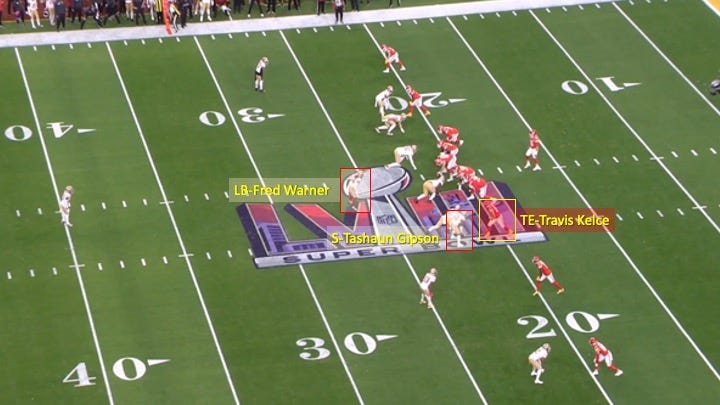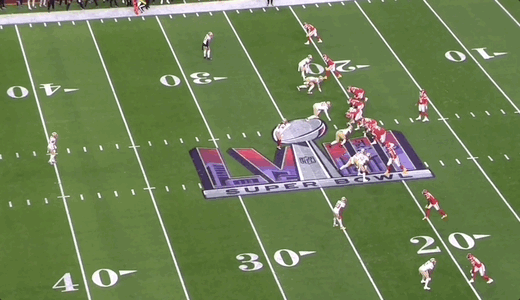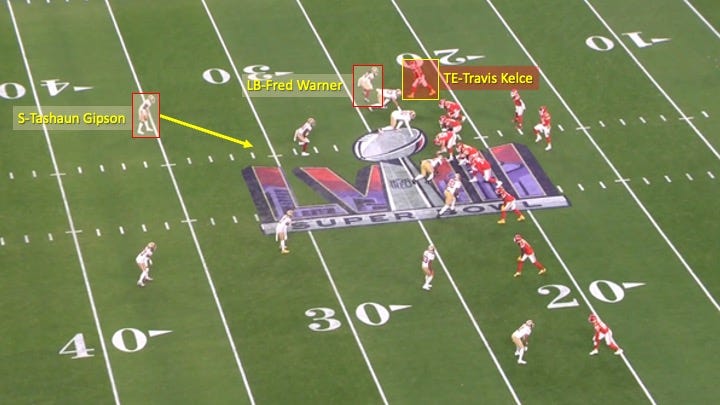Super Bowl LVIII Recap: Chiefs Offense vs. 49ers Defense
Steve Wilks and the 49ers defense came into Super Bowl LVIII with a great approach that helped them control the game for the first 3 quarters. But key adjustments by Andy Reid, the other-worldly abilities of Patrick Mahomes, and a few breakdowns in coverage by the 49ers all combined to give the Chiefs their 3rd Lombardi Trophy in 5 seasons.
There’s a lot to break down in this one, so let’s dive in.
Handling Kelce
Travis Kelce is the engine that makes the Chiefs offense go. As Ed wrote before the Super Bowl, the 49ers needed to give him special attention. They couldn’t be quite as predictable as they had been all season, with their tendency being to play mostly zone on first and second down and then mix in more man coverage on 3rd down.
That same approach would have been a recipe for disaster, as Andy Reid would have been able to more easily dictate favorable matchups for Kelce against zone on those early downs.
Wilks clearly felt the same way, and he did an excellent job of not waiting until 3rd down to mix in man coverage and dedicate extra defenders to Kelce.
You could see it on Kansas City’s second drive of the game. This was a 1st-and-10. Notice safety Tashaun Gipson aligned in press position on Kelce with linebacker Fred Warner cheating towards him:
Gipson would jam Kelce at the snap with Warner ready to help inside. Mahomes peaked Kelce’s way initially but quickly moved on once he saw two defenders accounting for him.
The coverage was also tight where Mahomes was looking to the right, which made him hold the ball. That allowed Chase Young to get home for the sack after winning cleanly against left tackle Donovan Smith:
Kelce finished the first half with just 1 catch for 1 yard.
The 49ers won early and often on first down. That kept the Chiefs from getting into a rhythm as they were unable to stay ahead of the chains. Their initial 14 first-down plays gained 68 yards. But take away the 52-yard completion to Mecole Hardman, and it was just 13 plays for 16 yards.
Kansas City’s early-down struggles translated to more difficult third downs. They converted just 4 of 12 opportunities through the first 3 quarters, largely because half of those were 3rd-and-8 or more.
Kelce drew special attention on many of those 3rd downs, one of which resulted in an interception. Linebacker Fred Warner was matched on Kelce in man coverage on this play. Tashaun Gipson would drop down into the middle of the field to provide help inside with an eye on Kelce:
Warner jammed Kelce at the line, something the 49ers made a concerted effort to do for much of the night. He tried to disrupt his route as long as possible while staying to the outside and playing to his help in the middle.
Mahomes would eventually scramble after not being able to find any open receivers early. Then he fired his first interception in 7 playoff games:
It’s tough to tell if Mahomes overthrew Kelce, who broke open late, or if he just made a bad decision by forcing this to Marquez Valdes-Scantling. Either way, the 49ers were taking away easy completions to Kelce, and the Chiefs were starting to press.
So what changed? How did Kelce finish the game with 9 receptions for 93 yards, which led all pass catchers on either team?
Andy Reid made some adjustments, which he described after the game:
“They doubled [Kelce] early and then we came back to him in the 2nd half. Had him rub off of people [and] kind of do combination routes.”
The basic thinking here was to put Kelce in positions where the defense could not effectively double-team him. So Reid found ways to have other routes run interference.
The best example came with just 16 seconds left in the game with the Chiefs trailing by 3 and facing a 3rd-and-7.
Kansas City came out in a 1x3 formation with Kelce isolated to the backside. The 49ers matched up with Warner and again would have safety Tashaun Gipson dropping down inside to provide help:






